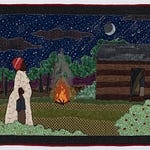1Psst! You should check out the essay companion to this audio dispatch. It’s full of cool links, resources, and other reference materials you’ll like.
Mythic Critique: Polaris Manifesto Part 4
Greetings! This is Part 4 in a series about myth, speculative fiction, and social change. Catch up on the rest of the series using the links below.
Transcript
[00:00:00] Welcome to Between Starshine and Clay, a weekly meditation on myth and culture by Jasmyne D. Gilbert. You are listening to the audio companion to my weekly newsletter with the same title. Before we dive in, I'm offering a gentle reminder that my buddy Elyse from Be More Connected has opened doors to The Growth Collective.
[00:00:19] If you are looking for ways to align your daily life with the rhythms of nature and the elements, you should consider joining the program. To quote her, through the four elements, The Growth Collective creates a space where you can own your power, honor your soul's calling, and transform in community. If you were drawn to this newsletter, you'd probably be really into Elyse's work too. Visit @iamelysepreston on Instagram to learn more about Elyse, Be More Connected, and The Growth Collective.
[00:00:52] This week's recitation comes from my February 26th, 2025 dispatch called Mythic Critique: Polaris Manifesto Part 4, and it's all about how people have used myth in villainous ways. This is the dispatch where I finally get the chance to talk about Avatar: The Last Airbender and a couple other of my problematic faves.
[00:01:14] It reads, Myth is not just once upon a time in ancient history. Myth is alive if you're paying attention. Throughout this series, I have mentioned the world building, expansive, and beautiful potential of myth and how it has helped me imagine a life beyond racial capitalism, climate collapse, and existential despair.
[00:01:36] World building and expansiveness aren't inherently positive, though. What about the terror and negativity people have used myth to sow in the world? Take the Agni Kai scene from Avatar: The Last Airbender and the recent Netflix remake as an example. I like both, for the record, which is apparently an unpopular opinion. Anyway, to punish his son Zuko for his supposed weakness, Fire Lord Ozai challenges the boy to an Agni Kai, a fire duel tied to notions of honor and dishonor, that led to Zuko's disfigurement and exile from his home. Agni Kai points to the term agnicayana, which is a complex ancient Vedic fire ritual during which participants build and tend an altar of sacred fire. The ritual emulates the creation of the cosmos according to Vedic texts.
[00:02:32] So the idea is that the person performing the ritual is also co-creating the universe. By basing their fictional genocidal, fascistic dictator on a real ritual, the creators of Avatar: The Last Airbender demonstrate how the world building fundamentals of myth can be used in nefarious ways.
[00:02:52] Following that line of thinking, did you know the Nazis were woo as fuck? Not in a fun way, like we discussed in the previous dispatch, but woo in a way that built a world that placed certain types of bodies, ethnicities, and religions atop a hierarchy and subjugated all others.
[00:03:14] I'm going to take a moment to quote myself, because you know, self citation is my favorite, so I'm just going to take a minute to do that. "Heinrich Himmler's position granted him administrative control of the resources of the SS-Ahnenerbe, a branch of the SS that researched the ancient roots of German and by extension Aryan culture, and therefore much of the work done by its members made use of philology, folklore, and archaeology as windows into the pre Christian past. In 1936, after encountering the book Crusade Against the Grail, Himmler commissioned Otto Rahn to lead the Nazi search for the Holy grail in Iceland, and to explore more of Himmler's own mystical interests. He used the SS-Ahnenerbe to pursue his own esoteric interests and belief in Aryan superiority with resources the Third Reich had acquired in part through property theft from Jewish prisoners during the Arisierung." I think that's how you say it, that means Aryanization.
[00:04:17] Let's not stop at Nickelodeon and esoteric Nazism. Another example, even closer to home, is the concept of manifest destiny, which is the idea that a divine power granted colonists the right to expand westward in the so called United States, decimate entire nations, and bend the land to one's will to build a settler colony.
[00:04:39] Some of my research has explored how quote, "a core element of the United States' civil religion is violence as demonstrated through such historic examples as our use of manifest destiny and genocidal violence against Indigenous communities to span the, expand the country's borders."
[00:04:58] Additional examples include systematizing and expanding the practice of chattel slavery, our Constitutional protection of firearms, and the cultural acceptance of the mass shootings that adhering to that social construct engenders -that social construct being the Constitution-
[00:05:15] and the disproportionality of the country's defense budget when compared with that for education, end quote.
[00:05:21] I quoted myself from two different papers about Nazi esotericism and US civil religion, respectively. Those are not published in full, but you can read portions of that previous research in the dispatch that I published called You Don't Need Another Octavia Butler Think Piece. I'll include a link to it in the transcript to this recitation.
[00:05:44] Back to the reading. This deranged, threatening mythology builds worlds that inspire the worst atrocities in history.
[00:05:52] Developing the skills to recognize world building practices in real life, and then honing our critical, counter-surveillance, and strategic capacities helps our communities recognize when we are living out myths that are unworthy of our consent. Mythic critique can help us spot the threads of the wireframes that make up our systems.
[00:06:15] I'm learning to use both the critical and constructive capacities of myth to envision new worlds; both are urgently necessary. It takes practice to learn how to see mythic frameworks at work in the world, to see where we are living out nefarious constructs, and instead choose to build worlds that are more compelling.
[00:06:34] It's important to read Hartman and Marx and Fanon and Foucault and Davis and Kelley and Kaba because they deftly dissect the systems of dominance in our world. They help us see where we are caught in a lethal web. It has also been just as important for me to read Butler and Jemisin and Morrison and Chambers and brown because they show me how to build worlds rooted in liberatory imagination, not just deconstruct them.
[00:07:03] It turns out that speculative fiction and myth are great outlets for practicing new worlds. I think Robin D. G. Kelley said it best in Freedom Dreams, The Black Radical Imagination. Quote “Without new visions, we don't know what to build, only what to knock down. We not only end up confused, rudderless, and cynical, but we forget that making a revolution is not a series of clever maneuvers and tactics, but a process that can and must transform us.”
[00:07:39] Pivoting now to the creative prompts: every part of the Polaris Manifesto includes a set of prompts designed to help you pull a new world from your imagination. Whether you're a writer, a visual artist, a musician, or something in between, use that spark of imagination to invite us into your creative vision.
[00:07:58] Prompt one: who is your favorite villain in pop culture, history, or otherwise? Alternatively, who is the most compelling Big Bad to you? Prompt two: what world do they promise to build? Three, what about that person's actions draws your attention? How would you describe their worst actions? Final prompt, make a case in support of your villain and a case against them.
[00:08:30] For each piece of this manifesto, I've curated several free audio, text, and video resources for you to enjoy,
[00:08:38] and this week, there are a lot of them because I want to demonstrate how pervasive and insidious myth making can be. I'm going to give a very quick blurb about all of them, doing my best to avoid spoilers, but please visit jasmynegilbert.substack.com for more details.
[00:08:59] Ursula K. Le Guin's The Ones Who Walk Away from Omelas is a short story about an act of horror that a fictional utopia has to commit to keep their society perfect. Andrewism has a political cults video on YouTube that calls out some of the key features of modern cults to help people recognize when they're caught up.
[00:09:19] The Lucille Clifton poem, Why Some People Be Mad at Me Sometimes is useful for thinking about cultural memory and trauma. The Imaginary Worlds podcast is incredible. If you love speculative fiction, sci fi, and fantasy, they've published a two part series on fantasy and fascism. It's really compelling. N. K.
[00:09:40] Jemisin wrote a short story called Emergency Skin that turns the typical notions of a post apocalyptic, technocratic dystopia on its head. It's a, it's a really fun ending. Rebecca Roanhorse's White Hills is a short story in a dark fiction anthology of Indigenous writers. It's called Never Whistle at Night. It is genuinely one of the most horrifying pieces of body horror I have ever encountered, and it's uncannily timely considering the discussions we're having around bodily autonomy and, you know, human rights.
[00:10:17] Altar of Fire is a documentary, again on YouTube, about the agnicayana fire ritual that I mentioned in the Avatar: The Last Airbender section of this dispatch. There's also a new show on Hulu called Paradise, which seems like a run of the mill political whodunit. Because the series trailer manages to be compelling without giving away the most central and dystopian element of the plot. Climate horror, technocrats again, romance, it's got everything. You should watch it, I really like it. The next three are sources I used for my research papers on Nazi esotericism and civil religion, respectively.
[00:10:53] The first is a book called The Secret King: The Myth and Reality of Nazi Occultism by Michael Moynihan and Stephen E. Flowers.
[00:11:00] The second is a book by Nicholas Goodrick-Clark called Black Sun: Aryan Cults, Esoteric Nazism, and the Politics of Identity. The last one is a journal article by Roberta Coles called Manifest Destiny Adapted for 1990s War Discourse: Mission and Destiny Intertwined. Closing out the list, the last CEU is a tweet from Trump Jr. about the Miss Universe pageant, which is a subtle commentary on eugenics and fascist beauty standards.
[00:11:31] There is a separate list of PDF and EPUB materials available exclusively for paid subscribers, so if you're feeling abundant, please consider signing up for a paid subscription to Between Starshine and Clay at only 6 dollars a month.
[00:11:45] That concludes Polaris Manifesto Part 4: Mythic Critique. If you enjoyed what you heard today, catch up on the rest of this series about myth, speculative fiction, and social change by visiting jasmynegilbert.substack.com. Please consider subscribing to Between Starshine and Clay and sharing this dispatch with a loved one.
[00:12:07] I'm looking for world builders and I know you can help them find me. Thank you for listening. Enjoy the rest of your week, and I look forward to being back in your inbox very soon.
Dispatch cover art: “Fire in the forest” by mikhail serdyukov on Unsplash.










